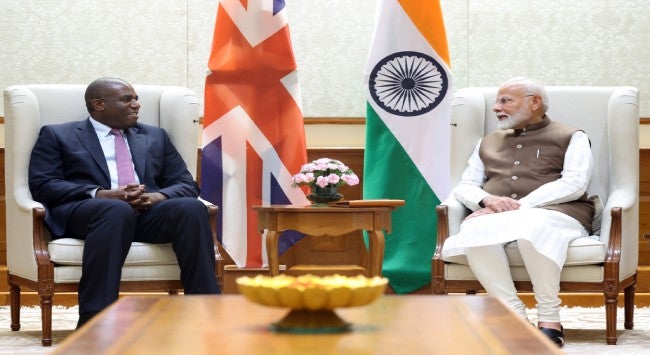Exploring New Frontiers:
UK-India Technology Security Initiative
Karthik Nachiappan, Mriganika Singh Tanwar
1 August 2024Summary
The United Kingdom’s Foreign Secretary David Lammy’s maiden visit to New Delhi in late July 2024 culminated in the launch of a new technology partnership – the Technology Security Initiative to leverage and catalyse technology cooperation with India.
The new Labour-led British government appears keen to propel relations with India. Capping off the visit of British Foreign Secretary David Lammy to New Delhi on 24 and 25 July 2024, the United Kingdom (UK) and India agreed to form a new Technology Security Initiative (TSI) to advance technology ties across several critical areas. What drove this incipient technology partnership? And can the initiative succeed?
Like the United States (US)-India Initiative on Critical and Emerging Technologies (iCET), the TSI will be led by the National Security Advisors of both countries, focusing on seven issues: telecommunications , critical minerals, semiconductors, artificial intelligence (AI), quantum, biotechnology and advanced materials. And like the iCET, the TSI hopes to spur and deepen cooperation between the two governments, technology companies, research and development institutions and academia. On issues like telecommunications and 5G/6G, critical minerals, semiconductors, AI, biotechnology and advanced materials, both establishments are investing heavily in research collaborations across universities and scientific institutions to drive the efforts. Unlike the iCET, however, the TSI prioritises coordination between both countries vis-à-vis technological global standards and norms governing the internet going beyond rules covering emergent issues like AI. Finally, departing from the iCET, the TSI does not have a clear defence trade and innovation component which commits both countries to produce defence technologies like drones, artillery and missiles.
The TSI builds on the existing India-UK Roadmap 2030 that the Boris Johnson government established in 2021 to elevate bilateral ties. The intent was to make the relationship more strategic, given the burgeoning convergence over defence and security cooperation in the Indo-Pacific. This renewed agenda hopes to drive the longstanding partnership between both countries, signalling a desire to explore emergent and untapped areas like critical and emerging technologies, spanning a whole litany of areas from quantum computing to clean energy. The TSI appears significant for both countries as one part of an array of initiatives that advance the UK-India Comprehensive Strategic Partnership. Talks are underway to establish bilateral mechanisms that deepen trade and innovation across their technological ecosystems. The TSI could also accelerate cooperation in areas like space as both countries move to exploit rising opportunities in that area.
How do we assess this bilateral technology initiative? The TSI is not India’s first attempt to collaborate with ‘trusted’ partners on technology and digital issues. Similar technology-focused partnerships exist with the US (iCET), the European Union (Trade and Technology Council) and through the Quadrilateral Security Dialogue. These bilateral partnerships, in turn, have widespread implications for the region at large. Such collaborations are meant to gradually produce a regional technology landscape that is fundamentally open, trusted and interoperable with considerable choice for the countries to devise new digital rules and standards, secure supply chains and provide credible and sustainable alternatives to procure technology to fuel growth and enhance security.
In this vein, such initiatives are designed for the long term with the hope that specific interactions and collaborations produce iterative outcomes that amplify and multiply over time. The intended and implicit reason driving these technology initiatives is China. The US-led allies and partners are increasingly engaging in new forms of technology cooperation to progressively limit the growth of China’s technology industry and curb its nefarious digital activities. Simultaneously, the initiative is designed to give insurance to countries with an overwhelming reliance on China or Taiwan for inputs like semiconductors, whose supply is threatened by a potential cross-straits crisis.
Like the iCET, the TSI’s impact is yet to be assessed. It will take time for intended outcomes to be realised; progress will require the government, private sector, industry and academia to support one another to achieve results. The TSI, for now, is the take-off point that facilitates institutionalised change and cooperation between the UK and India. That said, the potential for specific and immediate gains exists. On AI, the UK’s innovative AI research and development efforts could benefit India’s AI plans. Trade missions and dialogues on semiconductors could unlock opportunities for British firms to invest in India’s push to manufacture chips at home. Both countries can also work to provide telecommunications alternatives in the 5G and 6G space that enhance and not compromise digital and network security. Above all, the initiative exemplifies a convergence of interests between India and the UK over the Indo-Pacific strategy with technology at the forefront.
. . . . .
Dr Karthik Nachiappan is a Research Fellow at the Institute of South Asian Studies (ISAS), an autonomous research institute at the National University of Singapore (NUS). He can be contacted at isaskn@nus.edu.sg. Ms Mriganika Singh Tanwar is a Research Analyst at the same institute. She can be contacted at m.tanwar@nus.edu.sg. The authors bear full responsibility for the facts cited and opinions expressed in this paper.
Pic Credit: Narendra Modis Twitter Account
-
 More From :
More From :
-
 Tags :
Tags :
-
 Download PDF
Download PDF



